 USA (1887-90): Protected Cruiser C-7 Cininnatti C-8 Raleigh 1892-1921
USA (1887-90): Protected Cruiser C-7 Cininnatti C-8 Raleigh 1892-1921WW1 and prewar USN Cruisers
Atlanta class | USS Chicago | USS Newark | USS Charleston | USS Baltimore | USS Olympia | USS Philadelphia | USS San Francisco | Cincinatti class | Montgomery class | Columbia class | New Orleans class | Denver class | Chester class | Omaha classUSS New York | USS Brooklyn | Pennsylvania class | Saint Louis class | Tennessee class
The Cincinnati-class were two small protected cruisers built for the USN in 1889-94, respectvely C7 and C8 and preceded by the most famous USS Olympia, still preserved. They were smaller and more lightly armed and protected as intended for commerce raiding first and foremost. Given the Launch/Completion dates some authors called them Raleigh-class cruisers (she commissioned prior to Cincinnati). But the pennant order prevails in general. The Cincinnati-class cruisers were authorized by Congress act of 7 September 1888 and USS New York, Olympia and the Montgomery class. Both would take part in the Spanish-American war in 1898, on either theater.In 1903-1907 they served with the East Asia squadron and decommissioned in 1911, reactivated later for service in Asia and the gulf of Mexico. In 1917, Raleigh patrolled off Brazil and both were reunited in the Gulf of Mexico in 1918, decommissioned 1919 and BU 1921.
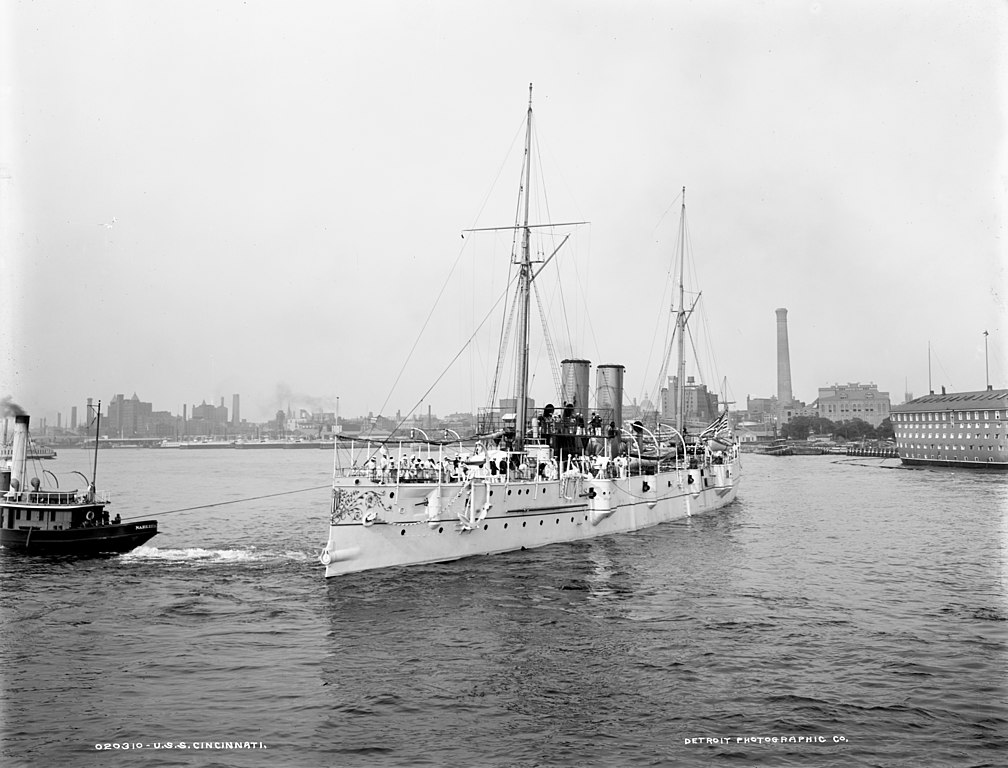
Development
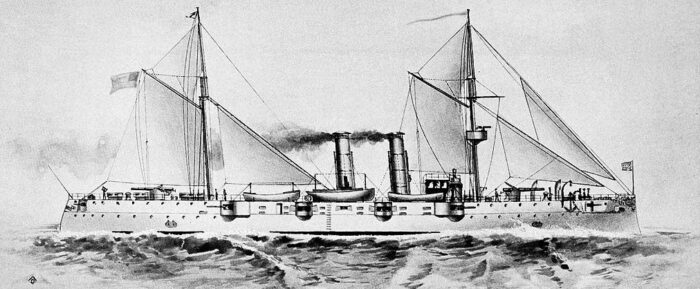
The transition from the old navy inherited from the civil war and the “new navy” was started wit the Atlanta class in 1885, and the incentive came from acquisitions in South America, notably Brazil. It was decided in 1886 to rebuilt a fleet of modern steel-hulled vessels in order to keep pace with advance of naval technology but also exploring many design concepts. Some cruisers for example were built in UK. US Yards managed to build a serie of protected cruisers both for coastal defence design and for commerce raiding. The USN expressed the need for two new small, unexpensive and fast commerce raiders, and this was voted as part of the 1888 naval appropriations bill. For the first time, Congress agreed to built five commerce raiders, in separate classes. These became the two Cincinnati class (3,000 tons) and three even smaller Montgomery class of 2,000 tons.
In May 1889, the Department of the Navy invited proposals for these two cruisers of 3,000 tons displacement each at a cost of c$1,100,000 each. William Cramp & Sons was the only one with a proposal but excessed the limit bid. The Department of the Navy optioned then an appropriation bill to change the amount and construct these cruisers in its own yards, with USS Cincinnati at Brooklyn and Raleigh at Norfolk Navy Yard.

USS Philadelphia’s Design
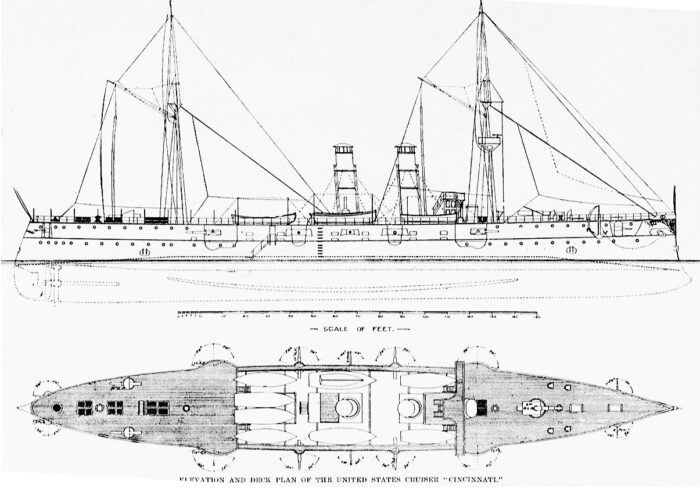
Depiction of USS Cincinatti on the American Engineer and Railroad Journal of 1893.
Hull and general design
These ships had a Displacement of 3,183 long tons (3,234 t) standard and 3,339 long tons (3,393 t) full load. They were an exploration of a simple, flush deck, forecastle and poop deck, two main guns and a complement of lighter guns sponsoned on the lower deck.
These ships were short at 305 ft 9 in (93.19 m) for a beam of 42 ft (13 m) and draft of 18 ft (5.5 m). The design was simple, with a lower battery deck about 1/3 of the total lenght, a pointed poop, modedate ram bow, two masts and a small bridge structure built aft of the the conning tower (only forward). The bridge had two wings on two levels for easy access with four stairs.
There access hathces at the poop to the crew’s quarters and a serie of air scoops. The ships had two tall funnels raked like the masts. The latter were composed of two parts with a fighting top only on the foremast, housing a Gatling. Complement was 312 officers and ratings, and each ship had nine boats, including six under davits, two yawls on deck and an extra cutter on tp pf a pinnace.
Powerplant
The Installed power in short, comprised two vertical triple expansion engines fed by six steam boilers (coal firing) for a total of 10,000 ihp (7,500 kW)
The engineering plant left some room for manoeuver for each yard, and this included six coal-fired cylindrical boilers provided by them, producing steam for two vertical triple expansion engines (VTE), also of free choice. This totalled an output on thge two propellers of 10,000 ihp (7,500 kW) as designed. The designed speed was of 19 knots (35 km/h; 22 mph).
On trials, USS Cincinnati reached 19.91 knots (36.87 km/h; 22.91 mph) from 7,070 ihp (5,270 kW) and Raleigh did way better, reaching 21.12 knots (39.11 km/h; 24.30 mph), but the horsepower was not measured or recorded. In addition, thse ships were, as shown on plans, fitted with a simple schooner rig on its fore and aft masts. Some references had them never carried, and this is not shown on photos anyway. A rigging was usual for commerce raiders, giving them reach, but in that case, the two masts far apart did not favored intensive rigging. Contrary to other cruisers like USS Newark or San Francisco among others, which had a barque rigging.
Range, wide, they carried in normal conditions some 556 tons of coal and their designed range was 8,652 nmi (16,024 km; 9,957 mi) at 10 knots (19 km/h; 12 mph). In wartime (like in 1898) it could be increased to 700 tons. However as tried, and in early service, it was shown this propulsion plant had a high coal consumption. These ships were bad steamers, and hardly could maintain 19 knots (35 km/h; 22 mph) for a long time. Both the boilers and engines were indeed replaced in later refits at the start of the century.
Protection
These ships were more lightly armoured to keep speed, having the bare minmum as protected cruisers: They had a protective deck with a thickness from 2 inches (51 mm) to 2.5 inches (64 mm) on the sloped sides. The middle flat section was just one inche (25 mm) thick. The guns sponsons on the battery deck were 4 inches (102 mm) thick on either sides. The conning tower forward went up for three levels, not round but flatter forward and aft, and made of 2 inches (51 mm) thick.
Armament
The main armament initially only comprised a single 6 inches (152 mm)/40 caliber main gun placed on the axis on the forward deck. It was shielded and provided some heavy-hitting power. It was completed by ten 5 in (127 mm)/40 caliber guns, more modern and faster-firing placed alongside the amidship lower battery deck and some in sponsons along the sides). Like the Olympia and the Montgomery classes they inaugurated these guns.
The secondary, light armament comprised eight 6-pounder (57 mm (2.2 in) rapid fire guns from Driggs-Schroeder Mk I/II and two 1-pounder (37 mm (1.5 in)) rapid fire guns Driggs-Schroeder Mk I, although their location is unclear. Four 6-pdr were installed in hull casemates fore and aft, two were located amidships. There was also a single Gatling gun (likely placed on the fighting top) and four 18 inch (450 mm) torpedo tubes on the broadside. Ther hatches were located fore and aft of the armoured turtle deck.
6-inch/40-caliber gun Mark 4
These new guns were designed in 1883 and produced from 1896 (until 1905). They were the more modern 6-inches in use in the USN. These guns equipped also early USN Battleships, USS Indiana, Massachusetts, Oregon, Illisnoise and Alabama, Wisconsin. The only cruisers which featured them were Cincinatti and Raleigh.
Specs: 13,370 lb (6,060 kg) without breech, Mod 0 256.1 in (6,500 mm).
Barrel length: 240 in (6,100 mm) bore (40 calibers).
It fired shells weighting 105 lb (48 kg) naval armor-piercing models.
Traverse: −150° to +150°.
Rate of fire: 1.5 rounds per minute, muzzle velocity 2,150 ft/s (660 m/s).
Effective range: 9,000 yd (8,200 m) at 15.3° elevation.
5-inch/40 (127 mm) Mark 2
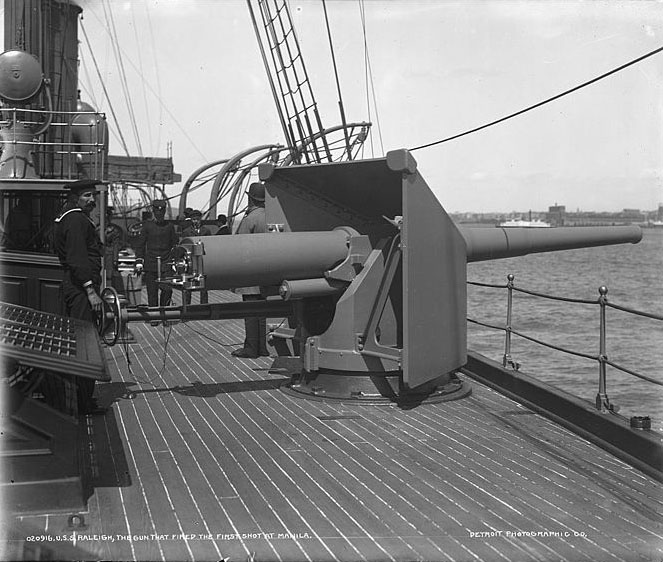
68 Mark 2 were built, and they weighted 7,000 lb (3,200 kg) without breech and 7,080 lb (3,210 kg) with breech.
The Barrel length was 200 in (5,100 mm) bore (40 calibers). −150° to +150°, open mount with shield.
Rate of fire: 12 rounds per minute, muzzle velocity 2,300 ft/s (700 m/s).
Effective firing range: 8,500 yd (7,800 m) at 15° elevation.
6-pounder (57 mm (2.2 in)) Driggs-Schroeder Mk I/II
Four of them, located in hull casemates fore and aft. 57x307R, 25 rpm, mv 1,818 feet per second (554 m/s) max range 4,000 yards (3,700 m).
3-pounder (47 mm (1.85 in)) Driggs-Schroeder Mk I/II
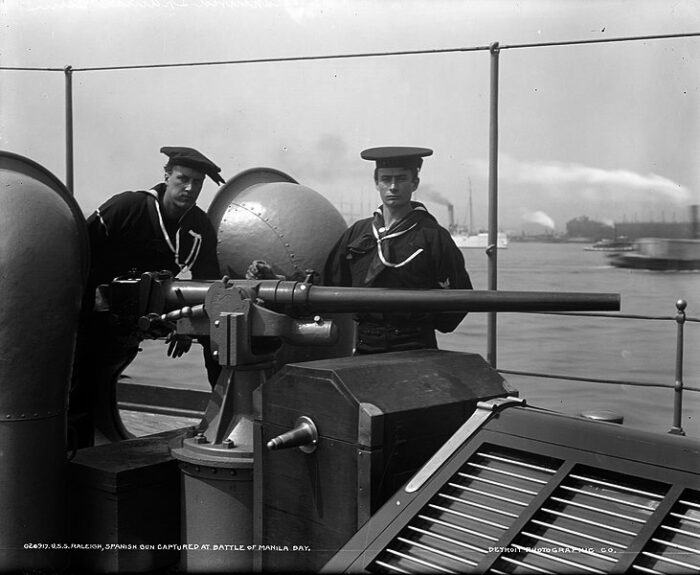
Four, located in the upper platforms on the roof of the main casemates fore and aft. Fixed QF 47×376 mm R 3 kg (6.6 lb), 30 rpm mv 571 m/s (1,870 ft/s) range 5.9 km (3.7 mi) at +20°.
1 pdr Driggs-Schroeder Mk I
Two 1-pounder (37 mm (1.5 in)) Hotchkiss revolving cannon located in the fighting tops alongside the two .45 caliber (11.4 mm) Gatling guns.
Similar to the British water-jacketed guns, rapid fire. The gun was originally a scaled up Maxim machine gun (Maxim-Nordenfelt 37 mm). It was belt fed, up to 300 rpm cyclic. mv 1,800 ft/s (550 m/s and max range 4,500 yards (4,110 m).
Upgrades
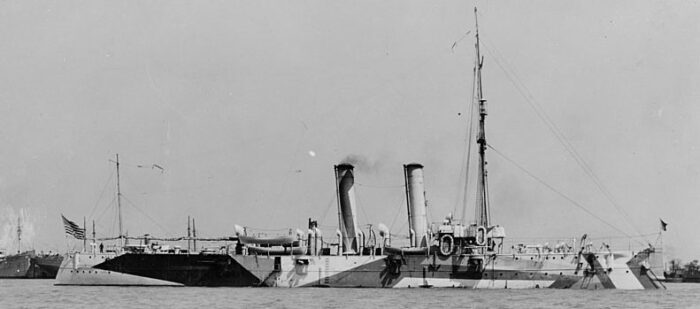
USS Cincinnati was refitted in 1899-1901 and Raleigh followed in 1899-1903. The single forward 6-inch gun was swapped for an extra 5-inch/40. The torpedo tubes were removed. Also, these were gutted to access the engine room. Instead of what was installed, Eight Babcock & Wilcox boilers took their place plus a lower powered, but more fuel-efficient triple-expansion engine.The new output was 8,500 ihp (6,300 kW) for a top speed of 18 knots (33 km/h; 21 mph). Two 5-inch guns (nine remaining) were also replaced in 1918.
So the final armament was now eleven 5 in (127 mm)/40 caliber guns, eight 6-pounder (57 mm (2.2 in)) guns, two 1-pounder (37 mm (1.5 in)) guns and one Gatling gun.
⚙ specifications |
|
| Displacement | 3,183 long tons (3,234 t) standard, 3,339 long tons (3,393 t) full load |
| Dimensions | 305 ft 9 in x 42 x 18 ft (93.19 x 13 x 5.5 m) |
| Propulsion | 2× VTE engines, 6× steam boilers, 10,000 ihp (7,500 kW) |
| Speed | 19 knots (35 km/h; 22 mph) |
| Range | 8,652 nmi (16,024 km; 9,957 mi) at 10 kn (19 km/h; 12 mph) |
| Armament | 1× 6 in/40, 10× 5 in/40 caliber, 8× 6-pdr, 2× 1-pdr, 1× Gatling gun, 4× 18 in TTs |
| Protection | Deck 2.5 in (64 mm), deck 1 in (25 mm), CT 2 in (51 mm), sponsons 4 in (102 mm) |
| Crew | 312 officers and enlisted |
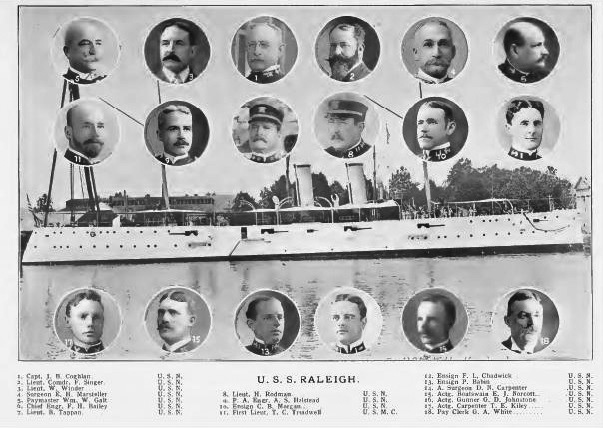
Both ships cruisers saw action in the Spanish–American War with USS Cincinnati off Cuba, Raleigh in the Philippines, and she is often crdited for firing the first shot of the Battle of Manila Bay. She stayed also to support US troops in the Philippine–American War. USS Cincinnati meanwhile was dipatched to protect US citizens and interests as unrest raged in the Caribbean. Both were posted in East Asia from 1903–1907 so aft refit. In 1911 they were decommissioned due to their age and new cruisers being completed. USS Cincinnati however was soon reactivated and sent as a station guardship for six years in East Asia and returned home to patrol in the Gulf of Mexico. USS Raleigh also stayed in Central America and gulf of Mexico between 1913 and 1916 as the revolution had impact on US interests in the region. Sje was drydocked for maintenance, and by April 1917 as the US entered war, Raleigh stayed around South America, notably from Brazil, and from mid-1918 she joined USS Cincinnati in the Gulf of Mexico to monitor possible U-Boat or commerce raiding activities. In mid-1919 they were decommissioned, latter scrapped in 1921. So, these small cruisers were never really tested as warships. They showed however that a small cruiser could perfectly fill many roles, aside commerce raiding. this was confirmed later by the even smaller Montgomery class, but they mostly showed that the USN needed gunboats above all else.
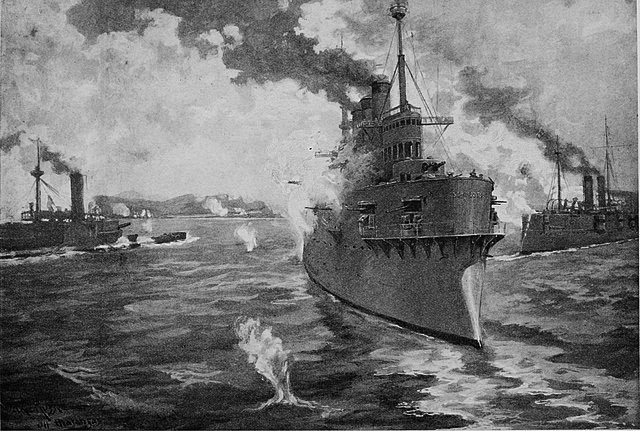
Career of USS Cincinatti and Raleigh
 USS Cincinnati (C-7)
USS Cincinnati (C-7)
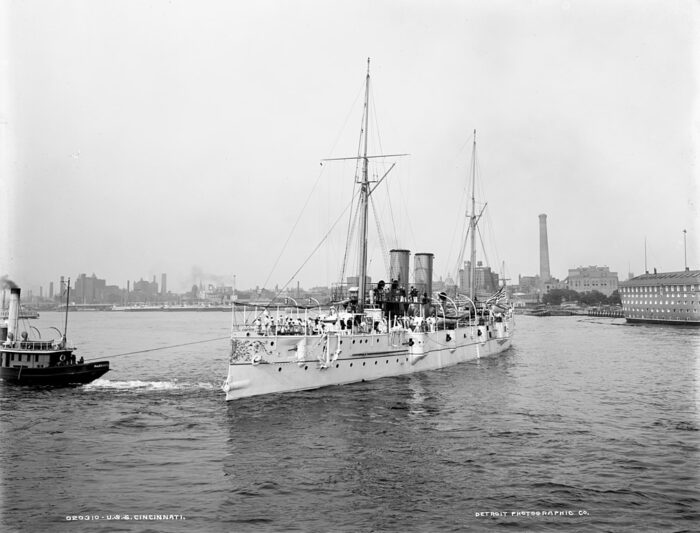
USS Cincinnati (C-7) was laid down at New York Navy Yard, Brooklyn (New York) on 29 January 1890 and launched on 10 November 1892. She was completed on 16 June 1894, named after the capital of North Carolina.
Her first cruise was on the east coast and Caribbean. Here, she was sent to enforce neutrality laws at Tampa and Key West as the Cuban Revolution rage on, from September 1895, until January 1896. From September 1896 to July 1897 she was sent to the eastern Mediterranean. She was back to the South Atlantic Station in September 1897. In April 1898 as the Spanish–American War flared up she was under command of Captain Colby Mitchell Chester. She Joined the blockade off Havana (Cuba) and shelled Matanzas and from May, she was in reconnaissance in the Carribean, looking for the relief Spanish fleet that was supposed to approach Cuba.
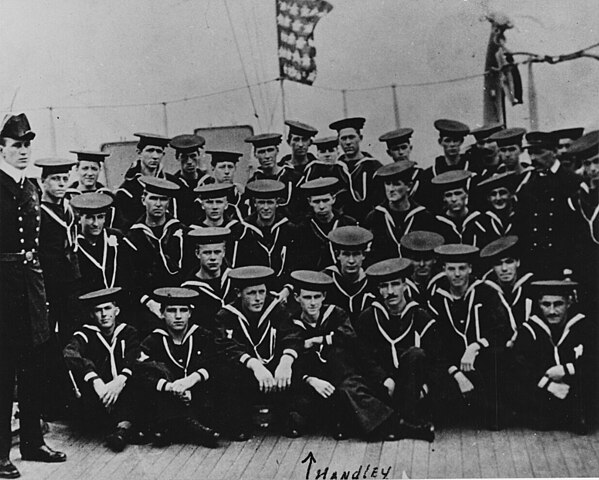
USS Cincinatti (C-7) and crew.
Later May, USS Cincinnati returned home for a quick refit and after re-training in Hamptopn roads, she was back in the Caribbean, this time for occupation duty. This was August. She protected troopships from Guantanamo Bay to Puerto Rico. Next she was on patrol off San Juan, and explored Culebra Island. She escorted the captured, battered flagship Infanta Maria Teresa as prize of war to home, but she sank en route to Norfolk. On 8–9 August she illuminated the troops fighting the Cape San Juan Light, provifing gunnery support in what became the Battle of Fajardo. She sailed for Santiago in November, then north, and between 14 February 1899 to 2 December 1901 she was decomissioned at New York Navy Yard, having an extensive ovberhaul (described above, nesw boilers, new VTE engine and new guns).
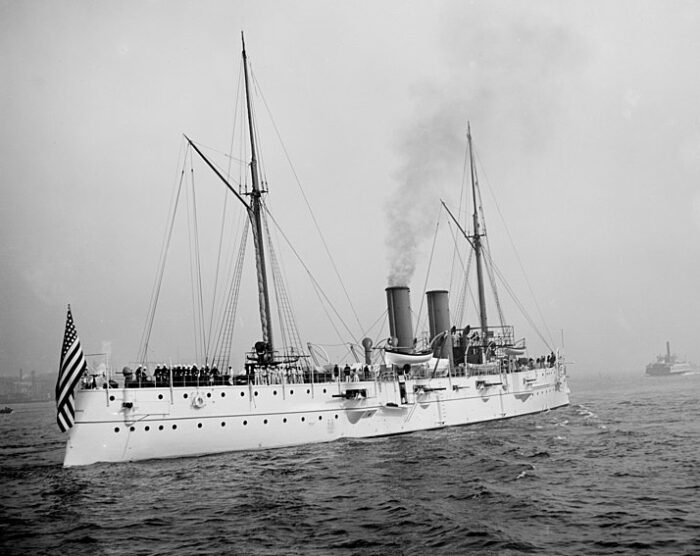
From May 1902 as she left the drydock, and performed retraining, and until January 1903, USS Cincinnati protected US citizens and property in the Caribbean. There were indeed unrest in Haiti, Santo Domingo, and Panama. She brought relief to Martinique after Mount Pelee eruption as well. From January to May 1903 she made her first cruise into the Mediterranean. While there, she sailed through the Suez Canal to join the Asiatic Station in the Philippines. Homeported to Manila, she would spent four years there. She was in many exercises and maneuvers with the accasional goodwill cruises, visiting China, Japan, or Pacific islands as well as Korea. She was back at Mare Island Navy Yard on 10 September 1907 to be decommissioned again on 12 October.
She was recommissioned in reserve on 8 March 1911, fully on 11 October 1911 and in December she was back with the Asiatic Station for six more year with the samez routin of gunnery drills, exercises and manoeuvers and port visits. She returned to San Diego on 16 December 1917 and while on the east coast she brought humanitarian relief to San Jose in Guatemala after earthquakes. She entered Hampton Roads on 16 January 1918.
She was made from there flagship of the American Patrol Detachment (Atlantic Fleet), patrolling the east coast from newfoundland to the guf of Mexico. from 1 February 1918 and until 28 March 1919, she patrolled indeed the Gulf of Mexico, based in Key West (Everglades). She protected vital oil supplies transfers and returned home to New Orleans or her formal decommission on 20 April. She was sold for BU on 4 August 1921.
 USS Raleigh (C-8)
USS Raleigh (C-8)
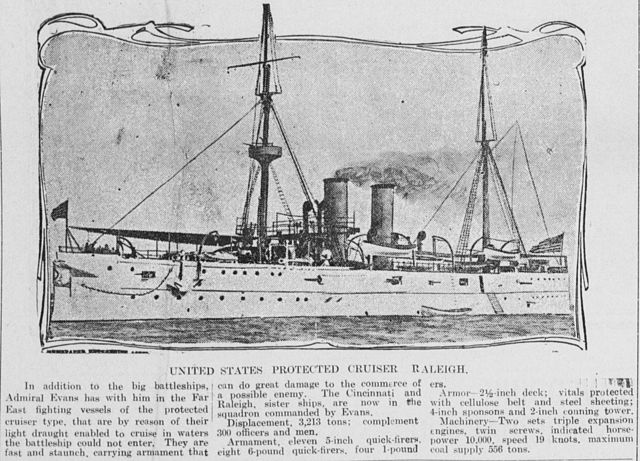
USS Raleigh (C-8) was laid down at Norfolk Navy Yard (Portsmouth, Virginia), after the Ohio city, second ship of the name. Laid down on 19 December 1889, she was launched on 31 March 1892, completed on 17 April 1894.
After initial training and shakedown in Chesapeake Bay, she entered a routine of training in 1895-98 and had a yard overhaul for five months. She was based in Hampton Roads. In January 1895 her fitting out was completed at the torpedo station Newport (Rhode Island). Her time with the North Atlantic Squadron included battle practice in the Caribbean. In June 1895 she was in New York. She cruised off Florida. She was back in NyC in August and spent the next 10 months in constant western Atlantic drills from New England to Florida.
The summer of 1896 saw her training Naval Militia in South Carolina-Louisiana. She was bacl later to North Atlantic Squadron manoeuvers. From late October 1896 until February 1897, she started neutrality patrol off Florida. She had a new overhaul at Nortfolk. From April she took part in ceremonies for the dedication of Grant’s Tomb.
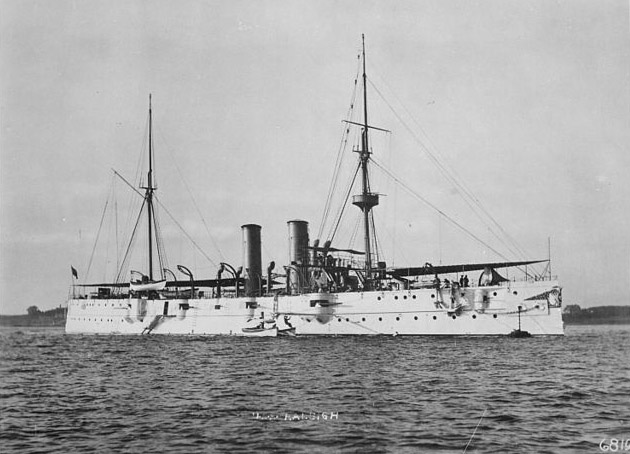
On 6 May 1897 she crossed the Atlantic for the Mediterranean, and on 11 June she arrived at Smyrna (Izmir) on the Aegean Sea. In July she was present for a good-will tour of Moroccan ports and from August, Italy. In December she was back off the Levant coast, and later that month she transited the Suez Canal for the Asiatic Station. On 18 February 1898 she arrived at the Hong Kong station and Admiral Dewey’s squadron.
On 26 April 1898 was was declared on Spain and on the 27th she sailed for Manila. Later that month, USS Raleigh passed El Fraile Island, and was surprised by a barrery which opened fire, but with poor accuracy. Soon joined by USS Concord and Boston, she was the first to open fire, in this preliminary of the battle. She continue scouting toward Cavite and discovered the Spanish fleet anchored there. USS Raleigh opened fire first from her 5-inch/40 caliber gun and took part in the forming column making a first passe on the Spanish vessels, all anchored, and at close range. Retunrne fire, when any, was rarely accurate.
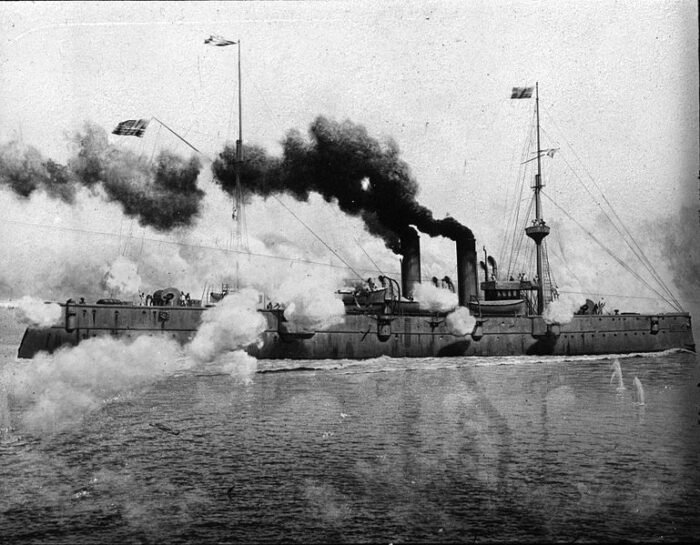
After two hours and five cross runs in Manila Bay (interrupted by a quick breakfast), the entire Armada was in flames. There was no casulaties. Next the Deway turned its attention to Shore batteries and before noon on 1 May, USS Raleigh joined Olympia, Boston, and Petrel. They rampegd trhough the navy yard and arsenal batteries. On 2 May, she sent a party ashore, notably officers to demand the surrender of Corregidor. A day later she was sent to disable batteries and destroy the munitions depot in Corregidor. Late afternoon, shore parties, including heirs, went to the battery of Palo Caballo and repeated the actions. USS Raleigh took up picket and patrol duties and captured the gunboat Callao on the 12th.
In July 1898 she sailed to Subic Bay and on the 7th, bombarded a battery on Grande Island until accepting surrender. Garrison troops were then landed ashore. On the 10th she was back in Manila, and stayed for support until the city surrendered by mid-August.
On the 25th she sailed for Hong Kong with mail and by early September was back in the Philippines. She was soon recalled for home and went through Suez, then Gibraltar, before reaching the United States on 15 December. On 15 April 1899 she was back in New York. The next day she was greeted by other ships and the crowd for her campaign.
She left New York for the Delaware River and Philadelphia to host on the 28th, President William McKinley and Secretary of the Navy John Davis Long. On 2 May, she toures ports in the Carolinas and arrived in Portsmouth to be decommissioned on 10 June, recommissioned on 5 January 1903. She had an overhaul at New York and sailed for Honduras, delivering relief. She left via Gibraltar and Suez for the Asiatic Fleet and entered Chefoo (China) on 26 August, hr new station.
She cruised off Korea, China and Japan and was frequently in the Philippines for diplomatic missions, showing the flag, conducting good-will tours. Chief Carpenter’s Mate Robert Klein was awared the Medal of Honor after the incident of 25 January 1904 when he rescued shipmates overcome by turpentine fumes. On 12 August 1907 she left Yokosuka for San Francisco (6 September) and Mare Island for inactivation, decommissioned on 12 October 1907.
USS Raleigh was recommissioned on 21 February 1911, sent to the Pacific Reserve Squadron in San Francisco and then Bremerton, staying her for two years without sortie. On 6 December 1913 she departed Puget Sound and joined the active fleet. She became a station ship at Manzanillo, Mazatlán, La Paz, and Guaymas over four years as the revolution rages on, to protect US interests. Once he was sent to Ocos, Guatemala (6–25 October 1915) and Corinto, Nicaragua (1 April-26 July 1916).
She had an overhaul at Mare Island in April 1917 and departed in May 1917. On 5 June she joined the Patrol Force, Atlantic Fleet like her sister, based in Newport with the Cruiser Force, 2nd Squadron. She spent her time patrolling between Boston to Norfolk and sent ti Brazilian waters, Rio on 12 December. Until 27 April 1918 she patrolled between there and Bahia inSalvador and in May, turned to West Africa to supplied amunitions to the Liberian Government. She stopped in Dakar, French West Africa and returned to South America on 18 May.
When German U-boats were signalled on the US east coast she was recalled home from 26 June, for Key West on 21 July. She escorted convoys in the Gulf of Mexico, and Caribbean, and South Carolina, until after the end of the war. In 1919 she remained in Key West. On 6 April she was sent to Charleston Navy Yard for inactivation and on 21 April, decommissioned for good. She was sold for scrap on 5 August 1921.
Read More/Src
Books
Bauer, K. Jack; Roberts, Stephen S. (1991). Register of Ships of the U.S. Navy, 1775–1990: Major Combatants. Greenwood Press.
Burr, Lawrence (2011). US Cruisers 1883-1904: The Birth of the Steel Navy. Osprey Publishing.
Friedman, Norman (1984). U.S. Cruisers: An Illustrated Design History. Annapolis, Maryland: Naval Institute Press.
Gardiner, Robert; Chesneau, Roger (1979). Conway’s All the World’s Fighting Ships 1860–1905.
Links
http://www.navsource.org/archives/04idx.htm
http://www.hazegray.org/navhist/cruisers/cruiser1.htm
https://www.history.navy.mil/research/histories/ship-histories/danfs/r/raleigh-ii.html
http://www.navweaps.com/Weapons/WNUS_5-40_mk2.php
http://www.navweaps.com/Weapons/WNUS_1pounder_m1.php
http://www.navweaps.com/Weapons/WNUS_6pounder_m1.php
https://www.navypedia.org/ships/usa/us_cr_cincinnati.htm
http://www.navsource.org/archives/04/c7/c7.htm
https://www.history.navy.mil/research/histories/ship-histories/danfs/c/cincinnati-ii.html
https://en.wikipedia.org/wiki/Cincinnati-class_cruiser

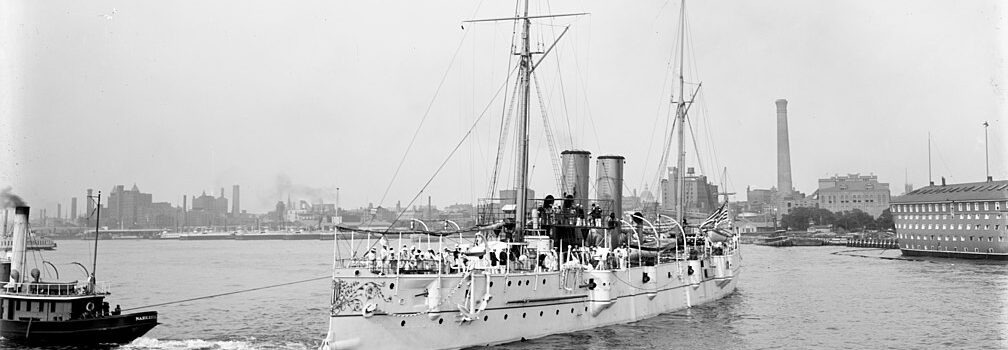
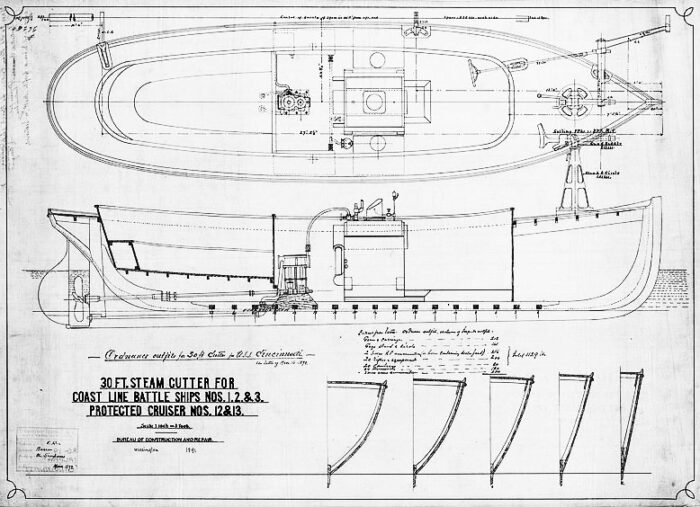
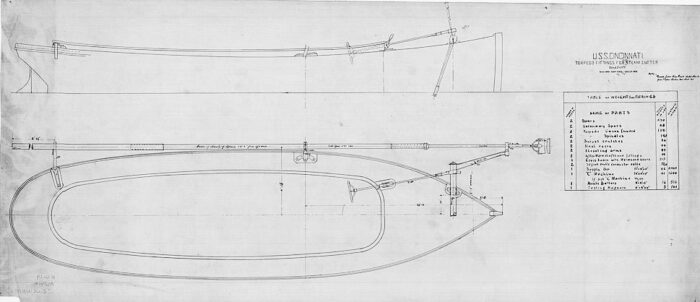
 Latest Facebook Entry -
Latest Facebook Entry -  X(Tweeter) Naval Encyclopedia's deck archive
X(Tweeter) Naval Encyclopedia's deck archive Instagram (@navalencyc)
Instagram (@navalencyc)





 French Navy
French Navy Royal Navy
Royal Navy Russian Navy
Russian Navy Armada Espanola
Armada Espanola Austrian Navy
Austrian Navy K.u.K. Kriegsmarine
K.u.K. Kriegsmarine Dansk Marine
Dansk Marine Nautiko Hellenon
Nautiko Hellenon Koninklije Marine 1870
Koninklije Marine 1870 Marinha do Brasil
Marinha do Brasil Osmanlı Donanması
Osmanlı Donanması Marina Do Peru
Marina Do Peru Marinha do Portugal
Marinha do Portugal Regia Marina 1870
Regia Marina 1870 Nihhon Kaigun 1870
Nihhon Kaigun 1870 Preußische Marine 1870
Preußische Marine 1870 Russkiy Flot 1870
Russkiy Flot 1870 Svenska marinen
Svenska marinen Søværnet
Søværnet Union Navy
Union Navy Confederate Navy
Confederate Navy Armada de Argentina
Armada de Argentina Imperial Chinese Navy
Imperial Chinese Navy Marinha do Portugal
Marinha do Portugal Mexico
Mexico Kaiserliche Marine
Kaiserliche Marine 1898 US Navy
1898 US Navy Sovietskiy Flot
Sovietskiy Flot Royal Canadian Navy
Royal Canadian Navy Royal Australian Navy
Royal Australian Navy RNZN Fleet
RNZN Fleet Chinese Navy 1937
Chinese Navy 1937 Kriegsmarine
Kriegsmarine Chilean Navy
Chilean Navy Danish Navy
Danish Navy Finnish Navy
Finnish Navy Hellenic Navy
Hellenic Navy Polish Navy
Polish Navy Romanian Navy
Romanian Navy Turkish Navy
Turkish Navy Royal Yugoslav Navy
Royal Yugoslav Navy Royal Thai Navy
Royal Thai Navy Minor Navies
Minor Navies Albania
Albania Austria
Austria Belgium
Belgium Columbia
Columbia Costa Rica
Costa Rica Cuba
Cuba Czechoslovakia
Czechoslovakia Dominican Republic
Dominican Republic Haiti
Haiti Hungary
Hungary Honduras
Honduras Estonia
Estonia Iceland
Iceland Eire
Eire Equador
Equador Iran
Iran Iraq
Iraq Latvia
Latvia Liberia
Liberia Lithuania
Lithuania Mandchukuo
Mandchukuo Morocco
Morocco Nicaragua
Nicaragua Persia
Persia San Salvador
San Salvador Sarawak
Sarawak Uruguay
Uruguay Venezuela
Venezuela Zanzibar
Zanzibar Warsaw Pact Navies
Warsaw Pact Navies Bulgaria
Bulgaria Hungary
Hungary

 Bundesmarine
Bundesmarine Dutch Navy
Dutch Navy Hellenic Navy
Hellenic Navy Marina Militare
Marina Militare Yugoslav Navy
Yugoslav Navy Chinese Navy
Chinese Navy Indian Navy
Indian Navy Indonesian Navy
Indonesian Navy JMSDF
JMSDF North Korean Navy
North Korean Navy Pakistani Navy
Pakistani Navy Philippines Navy
Philippines Navy ROKN
ROKN Rep. of Singapore Navy
Rep. of Singapore Navy Taiwanese Navy
Taiwanese Navy IDF Navy
IDF Navy Saudi Navy
Saudi Navy Royal New Zealand Navy
Royal New Zealand Navy Egyptian Navy
Egyptian Navy South African Navy
South African Navy






























 Ukrainian Navy
Ukrainian Navy dbodesign
dbodesign